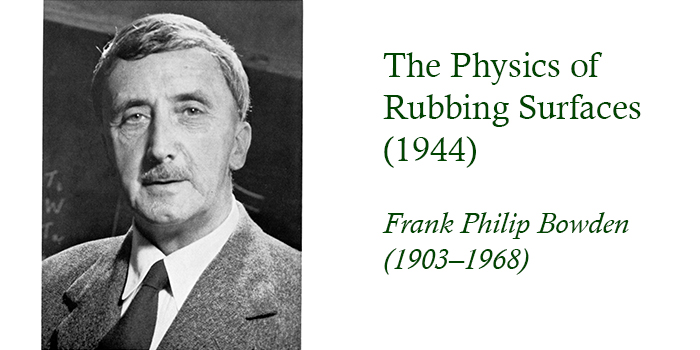5: The Physics of Rubbing Surfaces (1944)
Abstract
Two Liversidge Research Lectures delivered on October 17 and 18, 1944, at the Chemistry Department, University of Sydney, arranged by the Royal Society under the terms of the Liversidge Bequest. Reproduced by permission of the Royal Society of New South Wales from J. Proc. Roy. Soc. N.S.W., 1944, 78, 187–219.
"In this lecture we shall be dealing with a very old and very unfashionable branch of natural science - friction - and we wish to discuss some of the physical processes that occur when two solids are rubbed together."
"We shall confine our attention to some of the physical processes that occur when one solid slides over another. There is a resistance to motion which we call friction. What is the mechanism of that frictional force, and from the point of view of a molecule sitting on the surface, what is really happening?"
References
Atlee, Wilson and Filmer, 1940. J. App. Phys., 11, 611.
Beilby, 1921. " Aggregation and Flow of Solids", MacMillan & Co., London.
Boas and Honeycombe, 1944. Nature, 153, 494; 154, 338.
Bowden and Hughes, 1939. Proc. Roy. Soc., A, 172, 263.
Bowden and Tabor, 1939. Proc. Roy. Soc., A, 169, 391.
Cherry-Garrard, 1922. " The Worst Journey in the World ", 2, Constable & Co., London.
Greaves and Wrighton, 1939. " Practical Microscopical Metallography", Chapman & Hall, London.
Hardy, 1936. " Collected Works." Camb. Univ. Press.
Heidenreich and Matheson, 1944. J. App. Phys., 15, 423.
Hertz, 1881. J. reine angew. Math., 92, 156. Also Collected Works.
Holm, 1929. Wiss. Veröff. Siemens-Konz., 7 (2), 217-271.
Hunter, Churchill and Mears, 1942. Metal Progress, 42, 1070.
Langmuir, 1934. J. Franklin Inst., 218, 143.
Maxwell, 1873. " Electricity and Magnetism ", 1, Art. 308.
Nansen, 1898. " Farthest North ", 1, George Newnes, London.
Reynolds, 1901. " Papers on Mechanical and Physical Subjects ", 2, Camb. Univ. Press.
Sakmann, Burwell and Irvine, 1944. J. App. Phys., 15, 459.
Scott, 1933. " The Land that God gave Cain ", Chatto & Windus, London.
Wright, 1924. From " Miscellaneous Data " (Scott Polar Expedition of 1911-1913), compiled by Colonel H.G. Lyons. Harrison & Sons, London.

